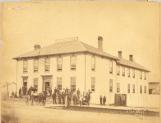1
The area's marine heritage began with the French explorers, including Champlain. It wasn't until the 1850s, though, that boatbuilding and shipbuilding began along the shore, the beginning of almost 140 years of sustained marine industry.This first stage of the industry was based on the manufacture of wooden vessels of all kinds, from skiffs to schooners, to cargo and passenger steamers.
3
The Lady Elgin was the first steam engine into the community along the new Ontario, Simcoe and Huron Railway. The coming of the train to Collingwood had an immediate impact on the boatbuilding and fishing industry already located in this tiny village. One of the first was a name change, from "Hen and Chickens Harbour" to "Collingwood." The railway was infrastructure for heavy industry in the area, providing the means to bring large volumes of heavy products to and from the Shipyard and the town.Photo credit: Collingwood Museum Collection Accession Number X972.152.1
5
James Lindsay was one of the first merchants to set up shop in Collingwood and capitalize on the marine connection. His dry goods store was just a stone's throw from the harbour. Notice that his carte-de-visite announces "Vessels Supplied at lowest rates."Photo credit: Collingwood Museum Collection Accession Number X974.111.1
7
Collingwood's first grain elevator helped to secure the community as one of the foremost transportation link, but also provided good incentive to the local farmers.Photo credit: Collingwood Museum Collection Accession Number 994.2.1a
8
Collingwood was deemed important enough to host the Prince of Wales' visit in September of 1860. 10,000 people thronged to our "frontier" town, and the pickpockets are said to have had a great day.10
The Chicora was one of many vessels that provided passenger and cargo transportation.An unknown diarist from Collingwood, a businessman, noted for July 23, 1875 that 600 "Menonites [sic]" had come through the town that day. "No good for Town," he notes, "Off the train, onto the boat." His comment makes sense: six hundred people passing through in one day likely made the hopes of the local merchants rise. The anticipated sales never materialized, because the Mennonites are known to have brought all of their own supplies and tools with them. Until the Canadian Pacific Railway was completed, much of the cargo and passengers heading for the West was sent via rail to Collingwood, then transferred to steamers here.
Photo credit: Collingwood Museum Collection Accession Number X974.2.92
12
One of the first buildings in town of any size was the North American Hotel, situated on the southwest corner of Huron and Hurontario Streets. It was only one of dozens of hotels and boarding houses set up by entrepreneurs in the young town. Note the all-important notice above the right doorway. Saloons and bars were another feature of the early years. Charles Cameron, the man in the buggy, was a later owner, and this photograph was taken c. 1870.Photo Credit: Collingwood Museum Collection Accession Number X969.817.1
14
Hundreds of working men came to the land of opportunity and found work. It was common for a young man to live at one of the hotels, if they were lucky enough to find lodging there. F. T. Hodgson wrote of the place that, even with all of the hotels in town, "thousands of people-at times- were forced to sleep on the wharf and docks. Every train-and specials-came in full to the doors-Scandinavians of all sorts, German and others, lined the wharfs, the hotel entrances, the sidewalks and every available dry spot was utilized for sleeping quarters…"Photo credit: Collingwood Museum Collection Accession Number X970.923.1





